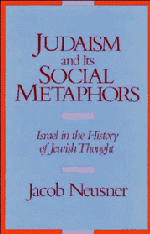Book contents
- Frontmatter
- Contents
- Preface
- List of Abbreviations
- Introduction
- 1 Imagining Society, Re-visioning “Israel”
- PART I “Israel” in the First Statement of Judaism, 70–300 C.E.
- 2 “Israel” in Relationship to Heaven
- 3 “Israel” in Relationship to “Non-Israel”
- 4 “Israel” in the Mishnah, the Tosefta, and Tractate Abot: A Probe
- 5 The First Phase of the Judaism of the Dual Torah and Its Social Metaphors
- PART II “Israel” in the Second Statement of Judaism, 300–600 C.E.
- PART III Same Metaphors, Other Systems
- General Index
- Index to Biblical and Talmudic References
4 - “Israel” in the Mishnah, the Tosefta, and Tractate Abot: A Probe
Published online by Cambridge University Press: 04 August 2010
- Frontmatter
- Contents
- Preface
- List of Abbreviations
- Introduction
- 1 Imagining Society, Re-visioning “Israel”
- PART I “Israel” in the First Statement of Judaism, 70–300 C.E.
- 2 “Israel” in Relationship to Heaven
- 3 “Israel” in Relationship to “Non-Israel”
- 4 “Israel” in the Mishnah, the Tosefta, and Tractate Abot: A Probe
- 5 The First Phase of the Judaism of the Dual Torah and Its Social Metaphors
- PART II “Israel” in the Second Statement of Judaism, 300–600 C.E.
- PART III Same Metaphors, Other Systems
- General Index
- Index to Biblical and Talmudic References
Summary
Explicit and Implicit Social Entities in the Mishnah and Tosefta
A survey of the way in which words are used presents a repertoire of mere possibilities. To see the way in which the Mishnah actually treats the category “Israel,” we now ask how the document speaks of (an) “Israel.” For this purpose we turn to suggestive selections, that first explicitly, then implicitly, testify to the social imagination at work in the consensus represented by the Mishnah's authorship – that is, how in the aggregate they portray that abstraction, “Israel,” as a society all at once and all together. For the present purpose we want to find out both what that authorship has to say and also how it forms its opinions. Accordingly, we take an interest in the mode, as much as in the result, of thought.
The most important lesson before us is this: The symbolic transaction involving the system's social entity takes place in mind and imagination. Concrete data from the world out there play a remarkably slight role. A general theory of matters applies also to the specific issues of “Israel,” whether nation, society, or caste. To begin with, Scripture had spoken of God through analogies – “in our image, after our likeness” – and once theological anthroplogy had undertaken to define the human person in God's image, theological sociology would follow suit. In this mode of analogical and contrastive thought, what carried preponderant weight was not the evidence of the streets and households but the generative problematic of the system as a whole.
- Type
- Chapter
- Information
- Judaism and its Social MetaphorsIsrael in the History of Jewish Thought, pp. 60 - 82Publisher: Cambridge University PressPrint publication year: 1989



